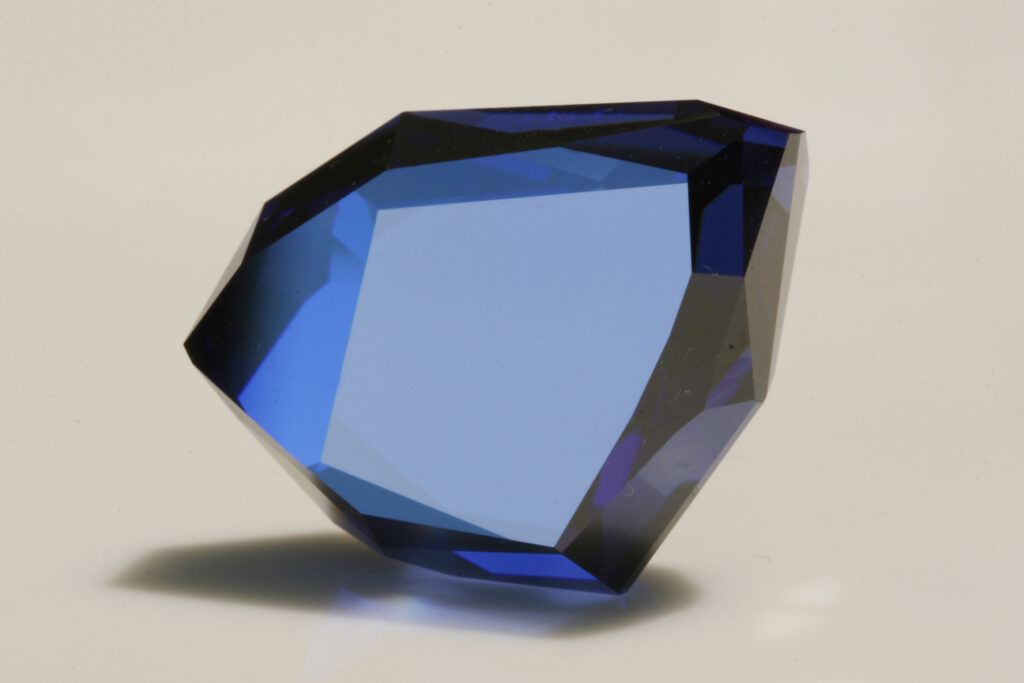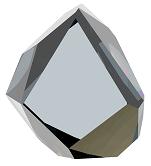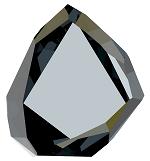
Specifications
Weight: 115.16 carats*
Dimensions: 32.89 x 27.65 x 12.92 mm**
Color: Blue
Weight of Rough: Unknown; semi-cut crystal
Origin: Golconda, India
Date Found: c. 1610
Current Location: Cut into the French Blue in 1671
*112 3/16 old carats
**Estimated from GemCad modeling.
Details
Much of the technical information concerning the Tavernier Blue was developed while researching the Hope diamond. Jean Baptiste Tavernier first saw the stone around 1668, and described it at the time as 112 3/16 carats (Tavernier, 1676). He fortunately provided the only known drawing of this stone so that it can be recreated. This process is covered in detail in the research page for the Hope Diamond.
One of the historical technical fictions about this stone relate that it is the size of a man’s fist. This is clearly not the case, as the replica is 32.89 x 27.65 x 12.92 mm as derived by GemCad modeling. For those unfamiliar with metric measurements, it is a little over an inch in length and width and half an inch deep If it were the size of a man’s fist, he would have had to reside in Oz.
April 2009
The finding of the French Blue replica in January 2008 (Farges et al, 2008, 2009) changes the Tavernier Blue model. Previous models only used Tavernier’s drawings as they were the only reference available. Now that the FB has been laser scanned and accurately modeled, it changes things.
The outline of the updated FB model has changed from the old one. Not much, but enough to make a difference, as the tolerances between the cut FB and the TB were extremely tight (certainly less than 0.1 mm for many edges). Now the new FB model did not fit inside the old TB model. But what should be changed to correct the TB model, as the FB must fit to comply with well-established history? Can’t change the new FB model, as that is based on 21st century laser scanning. That indicates that only the TB model can be changed. But how, as Tavernier’s drawing is the only reference?
The answer lies with Tavernier himself. He states ““If the stone is clean they do not do more than just touch it with the wheel above and below, and do not venture to give it any form, for fear of reducing the weight.” (1682, p. 56). So essentially a rough diamond was found, they touch up the crystal faces to give them a polish, and consider the work done. If this is the case, then the facets on the TB should correlate to crystal faces.
A hexoctahedral diamond crystal was modeled to provide facet settings (angle and index) of each of the faces. The updated FB model was placed inside the obsolete TB model and oriented within it. Then these combined models were oriented to the crystal model. In GemCad, pieces could be cut from the TB using crystal face settings as facet settings. The result was compared to the FB model to ensure that no pieces of the FB were removed in the process. A facet on the TB was considered “in place” when as much material was removed from the TB as possible without cutting into the FB, and it looked like it should in Tavernier’s drawing.
Once this preliminary model was complete, cleavage planes had to be accommodated. Can’t grind on a cleavage plane, and there were three facets that were, the Upper and Lower tables, and another facet on the Upper. So now these facets had to be recut away from the cleavage. The smaller one was easy, changing it by 3° was enough, plus the shape was more in line with its reference drawing. The two “tables” were more problematic. How far and in which direction to change their settings? This answer lies in the model of the FB, as the culet facet is tilted 3° in relation to the table facet. Since the table of the FB is the former table of the Under, the latter table is tilted 3° in the proper direction. Then, to maintain parallelism with the Upper table (as shown by Tavernier’s drawing), the Under table was also rotated. Unfortunately, recutting these two large facets by this much caused the French Blue to protrude at the TB”girdle”. So they were remodeled for only 2°. Now this skewed the appearance of all the facets surrounding the tables, so all facets had to be recut and repositioned (crystal angle and index settings were still used) to ensure these changes matched the historical drawing. The outcome was a TB model meeting the historical criteria of being the correct weight (±1%, 116.2 vs 115.3 cts), completely encloses the FB model, and looks similar to Tavernier’s drawing. More importantly, 21 of 31 facets directly correlated to crystal faces. Why is this important? (Think about this for a minute in relation to sister stones to the Hope before continuing to see if you can come up with the answer. Otherwise, keep reading.)
Since the historical criteria are all met by this model, and its position within a diamond crystal is known, the location of the cleavage planes is also known. “So what?” you ask? If the cleavages are known, now the dimension, shape, and weight of any cleavage piece can be determined as the TB is cut into the FB, and the FB cut into the Hope. You now know whether sister-stones to the Hope are possible, and their possible dimension, shape, and weight! This definitively puts to rest the question of the existence of sister-stones to the Hope. This has been printed in the Fall 2009 issue of Gems and Gemology (Sucher, 2009).


These computer generated images show the appearance of the Tavernier Blue diamond. A spectral file of the Hope diamond was imported to generate the exact color of the original diamond. Photoreal image generated using Diamcalc by Octonus (www.octonus.com)
